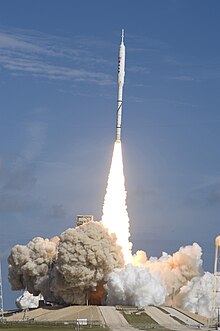Ares I
| ||
| Rodzina rakiet nośnych Ares | ||
 | ||
| Producent | Alliant Techsystems (1 stopień) Boeing (2 stopień) | |
| Data pierwszego startu | 28 października 2009 | |
| Data ostatniego startu | 28 października 2009 | |
| Statystyki | ||
| Wszystkie starty | 1 | |
| Udane starty | 1 (100%) | |
| Nieudane starty | 0 | |
| Zdolność wynoszenia | 25 t na LEO | |
| Wymiary | ||
| Długość | 94 m | |
| Średnica | 5,5 m | |
| Ilość stopni | 2 | |
| Stopnie rakiety | ||
| Stopień 1. | Pięciosegmentowa rakieta na paliwo stałe | |
| Stopień 2. | J-2X | |
Ares I – wchodzący w skład anulowanego Programu Constellation projekt rakiety nośnej dla pojazdu kosmicznego Orion. Był poprzednio znany pod nazwą Crew Launch Vehicle (ang. Pojazd Wynoszący Załogę) lub oznaczany skrótem CLV. Otrzymał też nieoficjalną nazwę "The Stick", czyli "Kijek", w związku ze swoim dość wysmukłym kształtem. W czerwcu 2006 r. NASA oficjalnie nadała pojazdowi nazwę Ares I. Ares odnosi się do greckiego boga wojny, którego rzymskim odpowiednikiem jest Mars. Tym sposobem, nazwa pojazdu nawiązuje do planowanych przez NASA wypraw na Marsa. Rzymska cyfra "I" jest nawiązaniem do rakiet Saturn I i Saturn IB, wykorzystywanych przez NASA w programie Apollo. Zaznaczony symbolicznie w logo rakiety wschód Słońca miał podkreślać początek nowej epoki podboju kosmosu. Dziesięć gwiazd symbolizuje centra NASA, a strzelający ku górze promień stanowi alegorię dążenia ku nieznanemu i potęgę ludzkiej wyobraźni[1].
Dane techniczne
- Wysokość: 93 m
- Masa startowa: 900 t
- Masa ładunku: 25 t
- Liczba członów: 2
- Napęd:
- Pierwszy stopień: Pięciosegmentowa rakieta na paliwo stałe, skonstruowana z wykorzystaniem rozwiązań z rakiety wspomagającej start wahadłowca.
- Drugi stopień: silnik J-2X zasilany ciekłym wodorem i tlenem.
Pierwsze loty
Pierwszy start wersji testowej rakiety (oznaczonej jako Ares I-X) odbył się 28 października 2009 r.[2] Ponieważ do tego czasu nie zostały zakończone prace nad elementami składowymi rakiety nośnej, w locie tym została wykorzystana czterosegmentowa wersja pierwszego stopnia przedłużona o makietę piątego segmentu. Dołączone też zostały makiety symulujące drugi stopień rakiety oraz wynoszony ładunek. Kolejny próbny lot (Ares I-Y) miał wykorzystywać pięciosegmentowy pierwszy stopień oraz stopień drugi, który miał być zaopatrzony w makietę silnika. Pierwszy lot próbny rakiety Ares I w gotowej konfiguracji był planowany na 2012 r., natomiast pierwsze wyniesienie na orbitę statku Orion z astronautami na pokładzie miało nastąpić w 2014 roku[3]. W 2010 roku program Constellation został anulowany.
Zobacz też
Przypisy
- ↑ Tim McElyea: Constellation. Warszawa: Prószyński Media Sp. z o.o., 2012, s. 18-21. ISBN 978-83-7839-087-9.
- ↑ Ares I-X launches – managers claim successful test flight (ang.). NASASpaceFlight.com, 2009-10-28. [dostęp 2013-12-04].
- ↑ Rocket Tests Planned for NASA’s Next Spaceship (ang.). space.com, 2006-09-06. [dostęp 2013-12-04].
Linki zewnętrzne
- Program Ares
- Folder z informacjami o Ares I (ang.)
- Informacje o locie Ares I-X i o rakiecie (ang.). Spaceflight Now, 2009-10-28. [dostęp 2013-12-04].
Media użyte na tej stronie
The flag of Navassa Island is simply the United States flag. It does not have a "local" flag or "unofficial" flag; it is an uninhabited island. The version with a profile view was based on Flags of the World and as a fictional design has no status warranting a place on any Wiki. It was made up by a random person with no connection to the island, it has never flown on the island, and it has never received any sort of recognition or validation by any authority. The person quoted on that page has no authority to bestow a flag, "unofficial" or otherwise, on the island.
CAPE CANAVERAL, Fla. - With more than 12 times the thrust produced by a Boeing 747 jet aircraft, the Constellation Program's Ares I-X test rocket roars off Launch Complex 39B at NASA's Kennedy Space Center in Florida. The rocket produces 2.96 million pounds of thrust at liftoff and goes supersonic in 39 seconds. Liftoff of the 6-minute flight test was at 11:30 a.m. EDT Oct. 28. This was the first launch from Kennedy's pads of a vehicle other than the space shuttle since the Apollo Program's Saturn rockets were retired. The parts used to make the Ares I-X booster flew on 30 different shuttle missions ranging from STS-29 in 1989 to STS-106 in 2000. The data returned from more than 700 sensors throughout the rocket will be used to refine the design of future launch vehicles and bring NASA one step closer to reaching its exploration goals. For information on the Ares I-X vehicle and flight test, visit http://www.nasa.gov/aresIX.
SVG version of PNG Space Shuttle Logo/Patch.
Ares 1 (February 2008)
MSFC-0800205 (8 Feb. 2008) -- A concept image shows the Ares I crew launch vehicle during ascent. Ares I is an in-line, two-stage rocket configuration topped by the Orion crew exploration vehicle and launch abort system. The Ares I first stage is a single, five-segment reusable solid rocket booster, derived from the space shuttle. Its upper stage is powered by a J-2X engine. Ares I will carry the Orion with its crews of up to six astronauts to Earth orbit.







